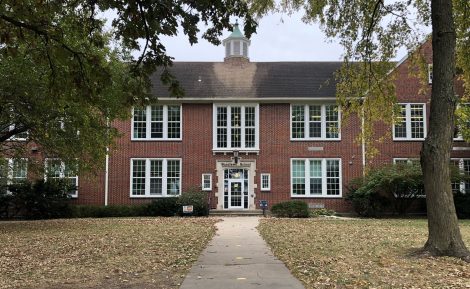Middle of the road: Lawrence elementary size neither biggest nor smallest

Supt. Randy Weseman walks along a Centennial School hallway in this photo from March 2003 on a tour of the building. Under the facility master plan, Centennial would be closed and its students moved to another school. Because of Centennial's proximity to Lawrence High School, Weseman envisioned the elementary school being used for special LHS activities.
Kansas districts
Maize
Elementaries (K-5): 4
Elementary enrollment: 2,825
Enrollment per building: 706.3
Blue Valley (Overland Park)
Elementaries (K-5): 20
Elementary enrollment: 9,548
Enrollment per building: 477.4
Olathe
Elementaries (K-6): 34
Elementary enrollment: 14,772
Enrollment per building: 434.5
Salina
Elementaries (K-5): 8
Elementary enrollment: 3,367
Enrollment per building: 420.9
Shawnee Mission
Elementaries (K-6): 35
Elementary enrollment: 14,563
Enrollment per building: 416.1
Wichita
Elementaries (K-5): 58
Elementary enrollment: 23,690
Enrollment per building: 408.4
Lawrence
Elementaries (K-6): 15
Elementary enrollment: 5,203
Enrollment per building: 346.9
Manhattan
Elementaries (K-6): 9
Elementary enrollment: 3,105
Enrollment per building: 345
Derby
Elementaries (K-5): 9
Elementary enrollment: 3,076
Enrollment per building: 341.8
Kansas City, Kan.
Elementaries (K-5): 30
Elementary enrollment: 9,876
Enrollment per building: 329.2
Topeka
Elementaries (K-5): 21
Elementary enrollment: 6,875
Enrollment per building: 327.4
Hutchinson
Elementaries (K-6): 8
Elementary enrollment: 2,604
Enrollment per building: 325.5
Geary County
Elementaries (K-5): 14
Elementary enrollment: 4,199
Enrollment per building: 299.9
Lawrence is in the middle.
Among 13 of the state’s larger school districts, Lawrence is seventh in the number of elementary students it has per school, according to enrollment numbers for this school year.
As school board members grapple with choices — including closing elementary schools — to cut an expected $5 million budget gap for next year, those involved in the discussions say it’s not a surprise how Lawrence compares.
Additional information
“Because the elementary schools have been built and planned over such a long period of time, that kind of affects what you may want to do,” said Frank Harwood, the district’s chief operations officer.
Lawrence has a mix of smaller buildings and larger ones because Lawrence did not build a new elementary school between 1967 and 1988. Most of the older smaller schools are closer to the Kansas University campus, and the larger ones are farther from downtown, including Sunflower, Quail Run and Langston Hughes in west Lawrence.
While closing smaller schools for savings is an option on the table, members of Save Our Neighborhood Schools, an organization asking the school district not to close any schools, say the smaller buildings add to the city’s character.
“One of the wonderful things about Lawrence is our system of neighborhood schools,” said Chuck Epp, a group member. “I’m convinced it’s one of the things that makes Lawrence Lawrence.”
Numbers
Compared with other larger school districts, Lawrence has about 347 elementary students per elementary school.
The Maize district, which has four elementary schools, had the highest with 706.25 elementary students per school. Two Johnson County districts were the second and third highest — Blue Valley at 477.4 and Olathe at 434.5.
Lawrence most closely compares with Manhattan, which has 345 elementary students per school, and Derby, at 341 students. The Geary County school district was the lowest with 300 elementary students per school. That district, near Fort Riley, has 14 elementary schools.
Choices
Dale Dennis, a Kansas deputy education commissioner, said school districts that have experienced growth in the past decade tend to have newer buildings and fewer schools because they can hold more students. Older districts typically have more schools with smaller buildings.
He said overall the makeup of a district is up to local boards, and they generally decide how many schools to operate based on the student-teacher ratio they set and the size of the classrooms in their buildings.
“It’s easier when you are newer because they are more up to date, and they will have similar problems in 15 to 20 years,” Dennis said.
Harwood said Lawrence and some other districts in the state have traditionally kept smaller schools. He said it also can come with a cost because the district has more schools to run, making overall costs higher.
But Epp, a Cordley School parent and a KU associate professor of public administration, said school districts with larger and fewer schools tend to be suburban districts with less of a need for neighborhood schools.
“It’s one of the things that has enabled this district to have extraordinarily high achievement levels for students across the district,” Epp said. “Even our low-income and racially diverse schools have high achievement in comparison to other districts.”







